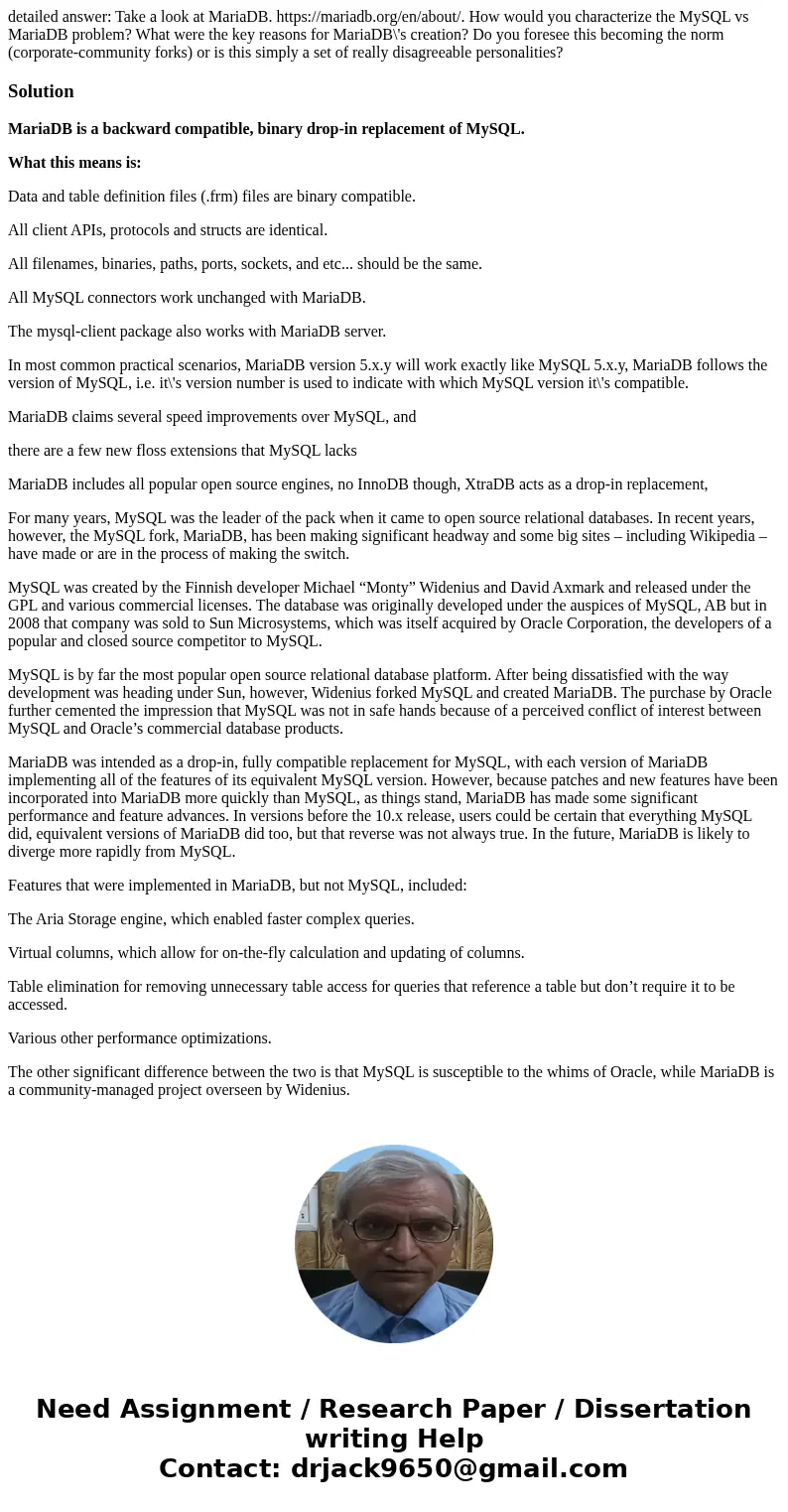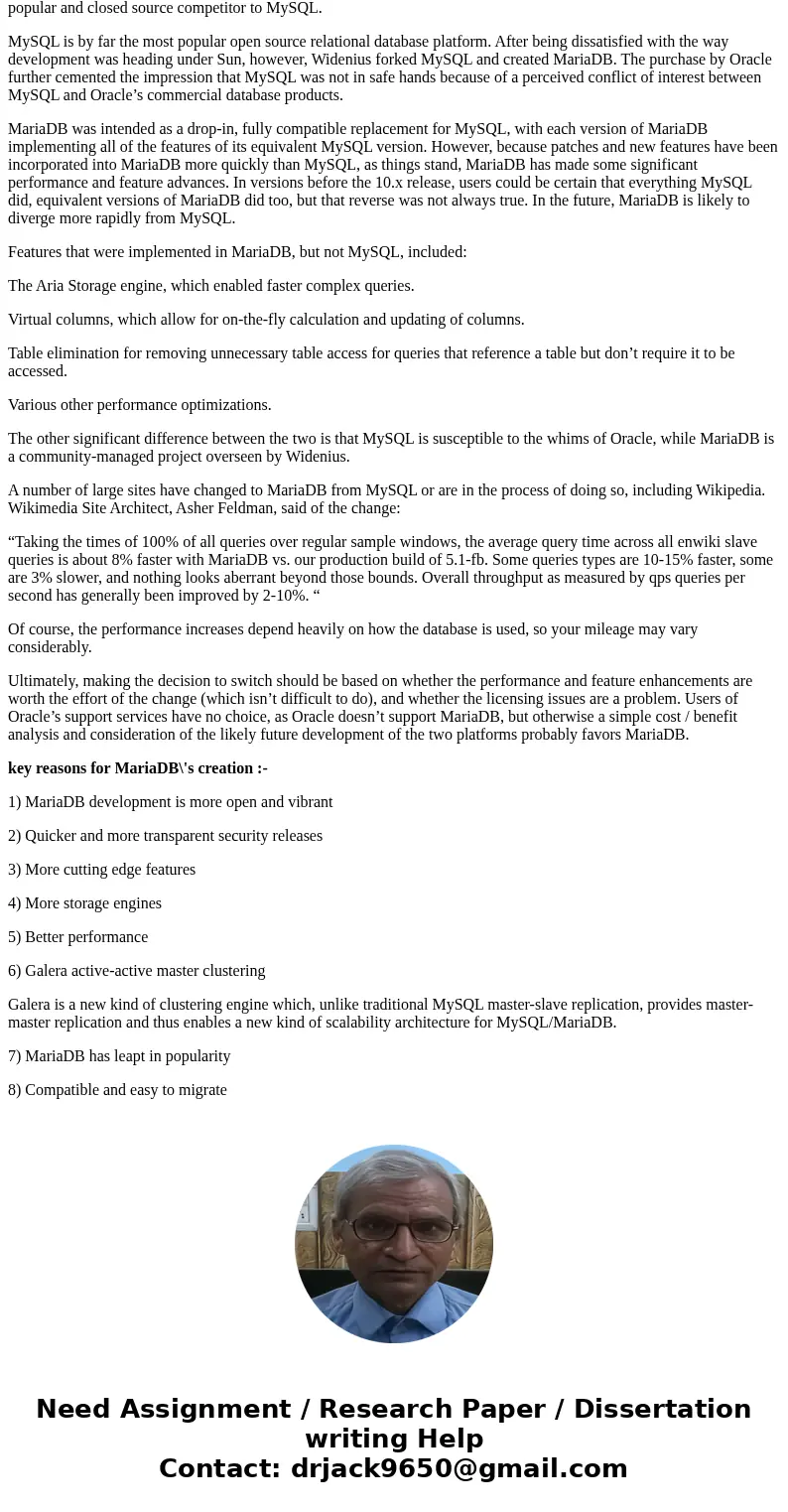detailed answer Take a look at MariaDB httpsmariadborgenabou
detailed answer: Take a look at MariaDB. https://mariadb.org/en/about/. How would you characterize the MySQL vs MariaDB problem? What were the key reasons for MariaDB\'s creation? Do you foresee this becoming the norm (corporate-community forks) or is this simply a set of really disagreeable personalities?
Solution
MariaDB is a backward compatible, binary drop-in replacement of MySQL.
What this means is:
Data and table definition files (.frm) files are binary compatible.
All client APIs, protocols and structs are identical.
All filenames, binaries, paths, ports, sockets, and etc... should be the same.
All MySQL connectors work unchanged with MariaDB.
The mysql-client package also works with MariaDB server.
In most common practical scenarios, MariaDB version 5.x.y will work exactly like MySQL 5.x.y, MariaDB follows the version of MySQL, i.e. it\'s version number is used to indicate with which MySQL version it\'s compatible.
MariaDB claims several speed improvements over MySQL, and
there are a few new floss extensions that MySQL lacks
MariaDB includes all popular open source engines, no InnoDB though, XtraDB acts as a drop-in replacement,
For many years, MySQL was the leader of the pack when it came to open source relational databases. In recent years, however, the MySQL fork, MariaDB, has been making significant headway and some big sites – including Wikipedia – have made or are in the process of making the switch.
MySQL was created by the Finnish developer Michael “Monty” Widenius and David Axmark and released under the GPL and various commercial licenses. The database was originally developed under the auspices of MySQL, AB but in 2008 that company was sold to Sun Microsystems, which was itself acquired by Oracle Corporation, the developers of a popular and closed source competitor to MySQL.
MySQL is by far the most popular open source relational database platform. After being dissatisfied with the way development was heading under Sun, however, Widenius forked MySQL and created MariaDB. The purchase by Oracle further cemented the impression that MySQL was not in safe hands because of a perceived conflict of interest between MySQL and Oracle’s commercial database products.
MariaDB was intended as a drop-in, fully compatible replacement for MySQL, with each version of MariaDB implementing all of the features of its equivalent MySQL version. However, because patches and new features have been incorporated into MariaDB more quickly than MySQL, as things stand, MariaDB has made some significant performance and feature advances. In versions before the 10.x release, users could be certain that everything MySQL did, equivalent versions of MariaDB did too, but that reverse was not always true. In the future, MariaDB is likely to diverge more rapidly from MySQL.
Features that were implemented in MariaDB, but not MySQL, included:
The Aria Storage engine, which enabled faster complex queries.
Virtual columns, which allow for on-the-fly calculation and updating of columns.
Table elimination for removing unnecessary table access for queries that reference a table but don’t require it to be accessed.
Various other performance optimizations.
The other significant difference between the two is that MySQL is susceptible to the whims of Oracle, while MariaDB is a community-managed project overseen by Widenius.
A number of large sites have changed to MariaDB from MySQL or are in the process of doing so, including Wikipedia. Wikimedia Site Architect, Asher Feldman, said of the change:
“Taking the times of 100% of all queries over regular sample windows, the average query time across all enwiki slave queries is about 8% faster with MariaDB vs. our production build of 5.1-fb. Some queries types are 10-15% faster, some are 3% slower, and nothing looks aberrant beyond those bounds. Overall throughput as measured by qps queries per second has generally been improved by 2-10%. “
Of course, the performance increases depend heavily on how the database is used, so your mileage may vary considerably.
Ultimately, making the decision to switch should be based on whether the performance and feature enhancements are worth the effort of the change (which isn’t difficult to do), and whether the licensing issues are a problem. Users of Oracle’s support services have no choice, as Oracle doesn’t support MariaDB, but otherwise a simple cost / benefit analysis and consideration of the likely future development of the two platforms probably favors MariaDB.
key reasons for MariaDB\'s creation :-
1) MariaDB development is more open and vibrant
2) Quicker and more transparent security releases
3) More cutting edge features
4) More storage engines
5) Better performance
6) Galera active-active master clustering
Galera is a new kind of clustering engine which, unlike traditional MySQL master-slave replication, provides master-master replication and thus enables a new kind of scalability architecture for MySQL/MariaDB.
7) MariaDB has leapt in popularity
8) Compatible and easy to migrate


 Homework Sourse
Homework Sourse